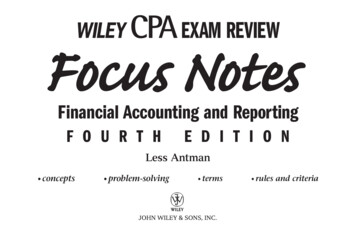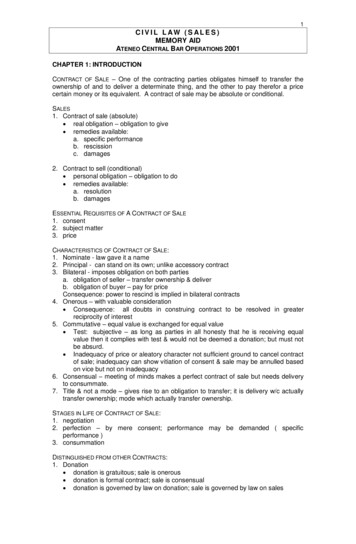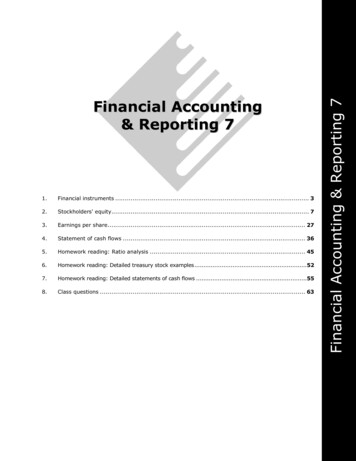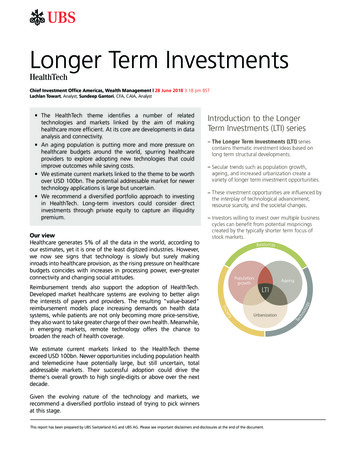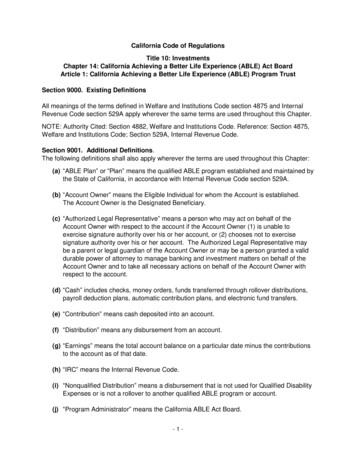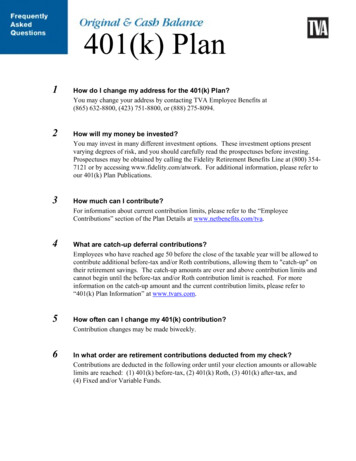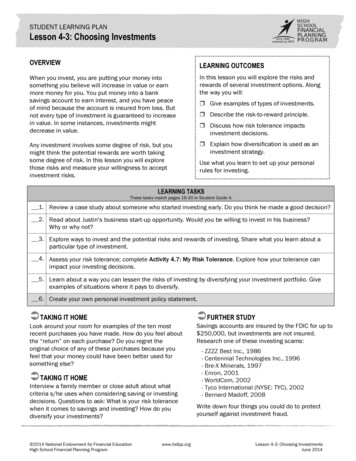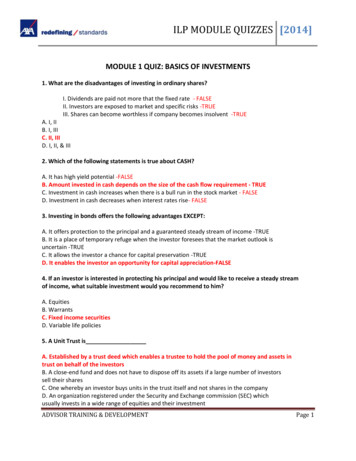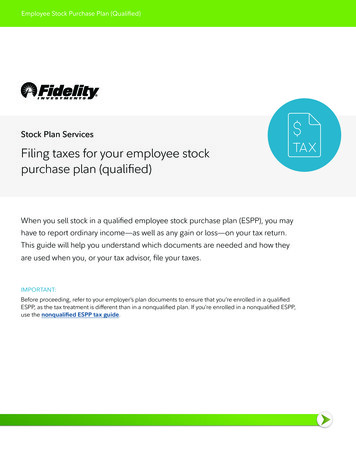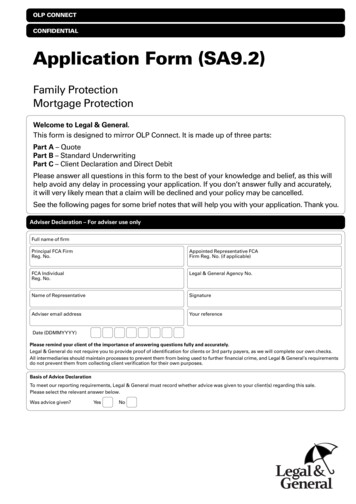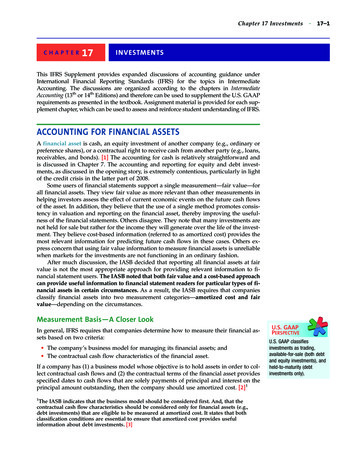
Transcription
Chapter 17 InvestmentsCHAPTER17·17–1INVESTMENTSThis IFRS Supplement provides expanded discussions of accounting guidance underInternational Financial Reporting Standards (IFRS) for the topics in IntermediateAccounting. The discussions are organized according to the chapters in IntermediateAccounting (13th or 14th Editions) and therefore can be used to supplement the U.S. GAAPrequirements as presented in the textbook. Assignment material is provided for each supplement chapter, which can be used to assess and reinforce student understanding of IFRS.ACCOUNTING FOR FINANCIAL ASSETSA financial asset is cash, an equity investment of another company (e.g., ordinary orpreference shares), or a contractual right to receive cash from another party (e.g., loans,receivables, and bonds). [1] The accounting for cash is relatively straightforward andis discussed in Chapter 7. The accounting and reporting for equity and debt investments, as discussed in the opening story, is extremely contentious, particularly in lightof the credit crisis in the latter part of 2008.Some users of financial statements support a single measurement—fair value—forall financial assets. They view fair value as more relevant than other measurements inhelping investors assess the effect of current economic events on the future cash flowsof the asset. In addition, they believe that the use of a single method promotes consistency in valuation and reporting on the financial asset, thereby improving the usefulness of the financial statements. Others disagree. They note that many investments arenot held for sale but rather for the income they will generate over the life of the investment. They believe cost-based information (referred to as amortized cost) provides themost relevant information for predicting future cash flows in these cases. Others express concern that using fair value information to measure financial assets is unreliablewhen markets for the investments are not functioning in an ordinary fashion.After much discussion, the IASB decided that reporting all financial assets at fairvalue is not the most appropriate approach for providing relevant information to financial statement users. The IASB noted that both fair value and a cost-based approachcan provide useful information to financial statement readers for particular types of financial assets in certain circumstances. As a result, the IASB requires that companiesclassify financial assets into two measurement categories—amortized cost and fairvalue—depending on the circumstances.Measurement Basis—A Closer LookIn general, IFRS requires that companies determine how to measure their financial assets based on two criteria: The company’s business model for managing its financial assets; and The contractual cash flow characteristics of the financial asset.If a company has (1) a business model whose objective is to hold assets in order to collect contractual cash flows and (2) the contractual terms of the financial asset providesspecified dates to cash flows that are solely payments of principal and interest on theprincipal amount outstanding, then the company should use amortized cost. [2]11The IASB indicates that the business model should be considered first. And, that thecontractual cash flow characteristics should be considered only for financial assets (e.g.,debt investments) that are eligible to be measured at amortized cost. It states that bothclassification conditions are essential to ensure that amortized cost provides usefulinformation about debt investments. [3]U.S. GAAPPERSPECTIVEU.S. GAAP classifiesinvestments as trading,available-for-sale (both debtand equity investments), andheld-to-maturity (debtinvestments only).
17–2·IFRS SupplementFor example, assume that Mitsubishi (JPN) purchases a bond investment that itintends to hold to maturity. Its business model for this type of investment is to collectinterest and then principal at maturity. The payment dates for the interest rate and principal are stated on the bond. In this case, Mitsubishi accounts for the investment atamortized cost. If, on the other hand, Mitsubishi purchased the bonds as part of a trading strategy to speculate on interest rate changes (a trading investment), then the debtinvestment is reported at fair value. As a result, only debt investments such as receivables, loans, and bond investments that meet the two criteria above are recorded atamortized cost. All other debt investments are recorded and reported at fair value.Equity investments are generally recorded and reported at fair value. Equity investments do not have a fixed interest or principal payment schedule and therefore cannotbe accounted for at amortized cost. In summary, companies account for investmentsbased on the type of security, as indicated in Illustration 17-1.ILLUSTRATION 17-1Summary of InvestmentAccounting ApproachesType of InvestmentAssessment of Accounting CriteriaValuation ApproachDebt (Section 1)Meets business model (held-for-collection) andcontractual cash flow tests.Amortized costDoes not meet the business model test(not held-for-collection).Fair valueDoes not meet contractual cash flow test.Fair value*Equity (Section 2)*For some equity investments for which the investor exercises some control over the investee, use the equity method.We organize our study of investments by type of investment security; within eachsection, we explain how the accounting for investments in debt and equity securitiesvaries according to how the investment is managed and the contractual cash flow characteristics of the investment.SECTION 1 DEBT I NVESTMENTSDebt investments are characterized by contractual payments on specified dates of principal and interest on the principal amount outstanding. Companies measure debtinvestments at amortized cost if the objective of the company’s business model is tohold the financial asset to collect the contractual cash flows (held-for-collection). Amortized cost is the initial recognition amount of the investment minus repayments, plusor minus cumulative amortization and net of any reduction for uncollectibility. If thecriteria for measurement at amortized cost are not met, then the debt investment is valued and accounted for at fair value. Fair value is the amount for which an asset couldbe exchanged between knowledgeable willing parties in an arm’s length transaction. [4]Calculator Solution forBond PriceInputsN10I5PV?PMT4,000FV100,000AnswerDEBT INVESTMENTS—AMORTIZED COSTOnly debt investments can be measured at amortized cost. If a company like Carrefour(FRA) makes an investment in the bonds of Nokia (FIN), it will receive contractual cashflows of interest over the life of the bonds and repayment of the principal at maturity.If it is Carrefour’s strategy to hold this investment in order to receive these cash flowsover the life of the bond, it has a held-for-collection strategy and it will measure theinvestment at amortized cost.2–92,2782Classification as held-for-collection does not mean the security must be held to maturity.For example, a company may sell an investment before maturity if (1) the security does notmeet the company’s investment strategy (e.g., the company has a policy to invest in onlyAAA-rated bonds but the bond investment has a decline in its credit rating), (2) a companychanges its strategy to invest only in securities within a certain maturity range, or (3) thecompany needs to sell a security to fund certain capital expenditures. However, if acompany begins trading held-for-collection investments on a regular basis, it should assesswhether such trading is consistent with the held-for-collection classification. [5]
Chapter 17 Investments·17–3Example: Debt Investment at Amortized CostTo illustrate the accounting for a debt investment at amortized cost, assume thatRobinson Company purchased 100,000 of 8 percent bonds of Evermaster Corporationon January 1, 2011, at a discount, paying 92,278. The bonds mature January 1, 2016,and yield 10 percent; interest is payable each July 1 and January 1. Robinson recordsthe investment as follows.January 1, 2011Debt InvestmentsCash92,27892,278As indicated in Chapter 14, companies must amortize premium or discount usingthe effective-interest method. They apply the effective-interest method to bond investments in a way similar to that for bonds payable. To compute interest revenue, companies compute the effective-interest rate or yield at the time of investment and applythat rate to the beginning carrying amount (book value) for each interest period. Theinvestment carrying amount is increased by the amortized discount or decreased bythe amortized premium in each period.Illustration 17-2 shows the effect of the discount amortization on the interest revenue that Robinson records each period for its investment in Evermaster bonds.8% BONDS PURCHASED TO YIELD tizationCarryingAmountof /141/1/157/1/151/1/16 0 2 614c645677711746783823864907952 8,14199,048100,000 40,000 47,722 7,722 4,000 100,000 .08 6 12 4,614 92,278 .10 6 12c 614 4,614 4,000d 92,892 92,278 614abRobinson records the receipt of the first semiannual interest payment on July 1,2011 (using the data in Illustration 17-2), as follows.July 1, 2011CashDebt InvestmentsInterest Revenue4,0006144,614Because Robinson is on a calendar-year basis, it accrues interest and amortizes thediscount at December 31, 2011, as follows.December 31, 2011Interest ReceivableDebt InvestmentsInterest Revenue4,0006454,645Again, Illustration 17-2 shows the interest and amortization amounts.U.S. GAAPPERSPECTIVEHeld-to-maturity investmentsunder U.S. GAAP arerecorded at amortized cost.ILLUSTRATION 17-2Schedule of InterestRevenue and BondDiscount Amortization—Effective-Interest Method
17–4·IFRS SupplementRobinson reports its investment in Evermaster bonds in its December 31, 2011,financial statements, as follows.3ILLUSTRATION 17-3Reporting of BondInvestments atAmortized CostStatement of Financial PositionLong-term investmentsDebt investmentsCurrent assetsInterest receivable 93,537 4,000Income StatementOther income and expenseInterest revenue ( 4,614 4,645) 9,259Sometimes, a company sells a bond investment before its maturity. For example,Robinson Company may sell securities as part of a change in its investment strategyto move away from five-year debt investments, like the Evermaster bonds, to invest inshorter-term bonds. Such a strategy would allow the bonds to reprice more frequently inresponse to interest rate changes. Let’s assume that Robinson Company sells its investment in Evermaster bonds on November 1, 2013, at 993 4 plus accrued interest. The discount amortization from July 1, 2013, to November 1, 2013, is 522 ( 4 6 783). Robinsonrecords this discount amortization as follows.November 1, 2013Debt InvestmentsInterest Revenue522522Illustration 17-4 shows the computation of the realized gain on the sale.ILLUSTRATION 17-4Computation of Gain onSale of BondsSelling price of bonds (exclusive of accrued interest)Less: Book value of bonds on November 1, 2013:Amortized cost, July 1, 2013Add: Discount amortized for the period July 1, 2013,to November 1, 2013 99,750 95,67152296,193Gain on sale of bonds 3,557Robinson records the sale of the bonds as:November 1, 2013CashInterest Revenue (4/6 4,000)Debt InvestmentsGain on Sale of Debt Investment102,4172,66796,1933,557The credit to Interest Revenue represents accrued interest for four months, for whichthe purchaser pays cash. The debit to Cash represents the selling price of the bondsplus accrued interest ( 99,750 2,667). The credit to Debt Investments represents thebook value of the bonds on the date of sale. The credit to Gain on Sale of Debt Investment represents the excess of the selling price over the book value of the bonds.3Although the example here is based on a single investment, the IASB indicates that companiesevaluate the investment strategy (or business model for managing the investments) at a higherlevel of aggregation than the individual security. As a result, a company may have more thanone investment strategy. That is, a company may hold a portfolio of investments that is managedto collect contractual cash flows and another portfolio of investments that is managed torealize gains and losses on fair value changes. [6]
Chapter 17 InvestmentsDEBT INVESTMENTS—FAIR VALUEIn some cases, companies both manage and evaluate investment performance on afair value basis. In these situations, these investments are managed and evaluatedbased on a documented risk-management or investment strategy based on fair valueinformation. For example, some companies often hold debt investments with theintention of selling them in a short period of time. These debt investments are oftenreferred to as trading investments because companies frequently buy and sell theseinvestments to generate profits in short-term differences in price.Companies that account for and report debt investments at fair value follow thesame accounting entries as debt investments held-for-collection during the reportingperiod. That is, they are recorded at amortized cost. However, at each reporting date,companies adjust the amortized cost to fair value, with any unrealized holding gainor loss reported as part of net income (fair value method). An unrealized holdinggain or loss is the net change in the fair value of a debt investment from one periodto another.Example: Debt Investment at Fair Value (Single Security)To illustrate the accounting for debt investments using the fair value approach, assumethe same information as in our previous illustration for Robinson Company. Recall thatRobinson Company purchased 100,000 of 8 percent bonds of Evermaster Corp
debt investments) that are eligible to be measured at amortized cost. It states that both classification conditions are essential to ensure that amortized cost provides useful information about debt investments.[3] CHAPTER17 INVESTMENTS This IFRS Supplement provides expanded discussions of accounting guidance under
